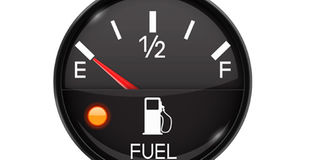How far can you go on reserve fuel ?

The amount of fuel on average for most cars can get you another 40 to 70 kilometres after the fuel warning light illuminates. Net Photo
What you need to know:
- Well, most of us have been in that predicament at one time or another. The fuel tank is getting low, perhaps the gauge is now pointing to “E” and the little light illuminates. How much longer do you have before you require the services of a boda boda to get some fuel in that Jerry can?
The detailed answer depends on all sorts of variables like the age and model of your car, how much weight you are carrying, and what kind of driving you are doing. The more fun answer is find out the hard way!
The interest in the low fuel warning light is strengthened by the fact that few people have any idea what it really means when the light is on.
As expected car manuals shall tell you how much fuel is left in your fuel tank when the low fuel light illuminates, that’s to say what the size of your reserve is.
The problem is that many being second, third or even fourth or fifth owners, car manuals are hard to come by. For cars from Japan, these manuals are in Japanese. Unless of course you spent some time in Japan, such a manual wouldn’t be of much use, would it?
Many newer cars go ahead to tell you conservatively how many kilometres on average you have left depending on your driving style and how much fuel is remaining in the tank. This is range of course changes drastically based on acceleration and load demands.
Additionally you have to remember that these newer cars’ fuel gauges are extremely accurate. When the needle is at E, you better fill up.
When the light goes on
Some people are just less inclined to run out of fuel surprises. Especially when they involve getting stranded. So they start to panic when the fuel light goes on.
The amount of fuel left in the tank when the low-fuel warning light is on varies greatly from car to car even within a particular model line.
When I was younger I would flawlessly drive huge distances when the needle was below the “E” in a Toyota Corolla. Also we have to note that the fuel gauge isn’t exactly the most precise instrument because of the inherent mechanical inefficiencies.
Gauge variations
Some gauges are so bad that the fuel light oscillates between on and off depending on the cars gradient. Some don't move linearly but make step movements.
Most manufacturers by and large have generous reserve tanks. There’s no standard for how big the fuel tank reserve is, but most of the time it’s about 10-15 percent of the overall size of the tank. The amount of fuel on average for most cars can get you another 40 to 70 kilometres after the fuel warning light illuminates.
That is of course if you are not in an ego testing race on the highway with some stranger.
When the light illuminates, I would recommend that the driver employ fuel saving driving practices immediately and refuels as soon as possible. The size of the reserve is logically proportional to the engine size.
How much fuel is left
If you really have to find out how much fuel your reserve tank has without the car manual, drive until the light illuminates, then immediately stop to fill all the way up and then comparing how much fuel your car took with the tank’s capacity.
Once you repeat this process a few times, you should have a fairly good estimate of how much fuel is left after the fuel warning light illuminates.
Electric fuel pumps
One thing worth mentioning, though is that lots of electric fuel pumps are very fussy about being run dry, and can burn out if you run out of fuel too often. So while it’s okay to take some risks, it’s best not to have that pump sucking air or debris at the bottom of the tank.
Take into consideration driving habits which can greatly affect your fuel economy and you shouldn’t be caught off-guard by that fuel light. This means if it illuminates, you should be able to finish up your errands and refuel when it is convenient.
When you run out of fuel
Sometimes, running out of gas makes the fuel pump fail. That’s because on some vehicles, the fuel cools and lubricates the fuel pump. When it doesn’t have gas any more, it seizes up. For this reason, experts recommend not leaving the ignition on when the car is running out of gas. There can also be other problems related to sediment in the fuel tank or issues with a lack of fuel in the system, according to the vehicle’s type and whether it is fuel injected. (Compiled from www.carsdirect.com)




